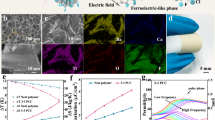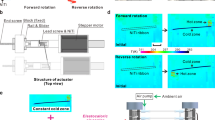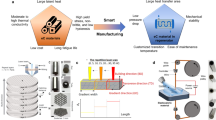Abstract
Cooling technology that is both compact and flexible is increasingly vital for the thermal management of wearable electronics and personal comfort. Electrocaloric (EC) cooling provides a potential solution, but the low adiabatic temperature change of EC materials has been the bottleneck in its progress. We demonstrate a cascade EC cooling device that increases the temperature change, with enhanced cooling power and cooling efficiency at the same time. The device integrates multiple units of EC polymer elements and an electrostatic actuation mechanism, all operating in synergy. Every two adjacent EC elements function in antiphase (in terms of both actuation and EC effect) to allow heat flow to be continuously relayed from the heat source to the heat sink. The antiphase operation also enables internal charge recycling, which enhances the energy efficiency. Operating at the EC electric field at which the adiabatic temperature change of the material is 3.0 K, a four-layer cascade device achieves a maximum temperature lift of 8.7 K under no-load conditions. The coefficient of performance is estimated to be 9.0 at the temperature lift of 2.7 K and 10.4 at zero temperature lift.
This is a preview of subscription content, access via your institution
Access options
Access Nature and 54 other Nature Portfolio journals
Get Nature+, our best-value online-access subscription
$29.99 / 30 days
cancel any time
Subscribe to this journal
Receive 12 digital issues and online access to articles
$119.00 per year
only $9.92 per issue
Buy this article
- Purchase on Springer Link
- Instant access to full article PDF
Prices may be subject to local taxes which are calculated during checkout




Similar content being viewed by others
Data availability
All data generated or analysed during this study are included in the published article and its Supplementary Information.
References
Jacobs, S. et al. The performance of a large-scale rotary magnetic refrigerator. Int. J. Refrig. 37, 84–91 (2014).
Lozano, J. A. et al. Performance analysis of a rotary active magnetic refrigerator. Appl. Energy 111, 669–680 (2013).
Tura, A. & Rowe, A. Permanent magnet magnetic refrigerator design and experimental characterization. Int. J. Refrig. 34, 628–639 (2011).
Nair, B. et al. Large electrocaloric effects in oxide multilayer capacitors over a wide temperature range. Nature 575, 468–472 (2019).
Qian, J. F. et al. Interfacial coupling boosts giant electrocaloric effects in relaxor polymer nanocomposites: in situ characterization and phase-field simulation. Adv. Mater. 31, 1801949 (2019).
Zhang, G. Z. et al. Colossal room-temperature electrocaloric effect in ferroelectric polymer nanocomposites using nanostructured barium strontium titanates. ACS Nano 9, 7164–7174 (2015).
Neese, B. et al. Large electrocaloric effect in ferroelectric polymers near room temperature. Science 321, 821–823 (2008).
Mischenko, A. S., Zhang, Q., Scott, J. F., Whatmore, R. W. & Mathur, N. D. Giant electrocaloric effect in thin-film PbZr0.95Ti0.05O3. Science 311, 1270–1271 (2006).
Zhang, Q. M., Bharti, V. & Zhao, X. Giant electrostriction and relaxor ferroelectric behavior in electron-irradiated poly(vinylidene fluoride-trifluoroethylene) copolymer. Science 280, 2101–2104 (1998).
Kabirifar, P. et al. Elastocaloric cooling: state-of-the-art and future challenges in designing regenerative elastocaloric devices. Stroj. Vestn. J. Mech. Eng. 65, 615–630 (2019).
Li, B. et al. Colossal barocaloric effects in plastic crystals. Nature 567, 506–510 (2019).
Lloveras, P. et al. Colossal barocaloric effects near room temperature in plastic crystals of neopentylglycol. Nat. Commun. 10, 1803 (2019).
Tusek, J. et al. A regenerative elastocaloric heat pump. Nat. Energy 1, 16134 (2016).
Shi, J. Y. et al. Electrocaloric cooling materials and devices for zero-global-warming-potential, high-efficiency refrigeration. Joule 3, 1200–1225 (2019).
Ozbolt, M., Kitanovski, A., Tusek, J. & Poredos, A. Electrocaloric refrigeration: thermodynamics, state of the art and future perspectives. Int. J. Refrig. 40, 174–188 (2014).
Chen, X. et al. Towards electrocaloric heat pump–a relaxor ferroelectric polymer exhibiting large electrocaloric response at low electric field. Appl. Phys. Lett. 113, 113902 (2018).
Li, X. Y. et al. Tunable temperature dependence of electrocaloric effect in ferroelectric relaxor poly(vinylidene fluoride-trifluoroethylene-chlorofluoroethylene terpolymer. Appl. Phys. Lett. 99, 052907 (2011).
Zhang, X. & Zhao, L. D. Thermoelectric materials: energy conversion between heat and electricity. J. Materiomics 1, 92–105 (2015).
Jia, Y. B. & Sungtaek, Y. A solid-state refrigerator based on the electrocaloric effect. Appl. Phys. Lett. 100, 242901 (2012).
Gu, H. M. et al. A chip scale electrocaloric effect based cooling device. Appl. Phys. Lett. 102, 122904 (2013).
Gu, H. M., Qian, X. S., Ye, H. J. & Zhang, Q. M. An electrocaloric refrigerator without external regenerator. Appl. Phys. Lett. 105, 162905 (2014).
Sinyavsky, Y. V. & Brodyansky, V. M. Experimental testing of electrocaloric cooling with transparent ferroelectric ceramic as a working body. Ferroelectrics 131, 321–325 (1992).
Plaznik, U. et al. Bulk relaxor ferroelectric ceramics as a working body for an electrocaloric cooling device. Appl. Phys. Lett. 106, 043903 (2015).
Ma, R. J. et al. Highly efficient electrocaloric cooling with electrostatic actuation. Science 357, 1130–1134 (2017).
Kitanovski, A. Energy applications of magnetocaloric materials. Adv. Energy Mater. 10, 1903741 (2020).
Snodgrass, R. & Erickson, D. A multistage elastocaloric refrigerator and heat pump with 28 K temperature span. Sci. Rep. 9, 18532 (2019).
Gu, H. M. et al. Simulation of chip-size electrocaloric refrigerator with high cooling-power density. Appl. Phys. Lett. 102, 112901 (2013).
Zhang, T., Qian, X. S., Gu, H. M., Hou, Y. & Zhang, Q. M. An electrocaloric refrigerator with direct solid to solid regeneration. Appl. Phys. Lett. 110, 243503 (2017).
Basiulis, A. & Berry, R. L. Solid-state electrocaloric cooling system and method. US patent 4,757,688 (1988).
Mathur, N. & Mishchenko, A. Solid state electrocaloric cooling devices and methods. GB patent PCT/GB2005/050207 (2005).
Bradesko, A. et al. Coupling of the electrocaloric and electromechanical effects for solid-state refrigeration. Appl. Phys. Lett. 109, 143508 (2016).
Pelrine, R., Kornbluh, R., Pei, Q. B. & Joseph, J. High-speed electrically actuated elastomers with strain greater than 100%. Science 287, 836–839 (2000).
Defay, E. et al. Enhanced electrocaloric efficiency via energy recovery. Nat. Commun. 9, 1827 (2018).
Campolo, D., Sitti, M. & Fearing, R. S. Efficient charge recovery method for driving piezoelectric actuators with quasi-square waves. IEEE Trans. Ultrason. Ferroelectr. Freq. Control 50, 237–244 (2003).
Acknowledgements
This work was supported by the Office of Naval Research (award no. N00014-19-1-2212).
Author information
Authors and Affiliations
Contributions
Y.M., Z.Z. and Q.P. conceived and designed the experiments. Y.M. and J.W. prepared EC polymer stacks. Y.M. and H. Wu designed the charge transfer circuit. R.W. built the charge transfer circuit. Y.M. and H. Wang fabricated the devices and performed the measurements. Y.M., Z.Z. and Q.P. analysed and interpreted the data. Y.M. simulated the cascade device performance. Y.M. and Q.P. organized the data and wrote the manuscript, and all authors reviewed and commented on the manuscript.
Corresponding author
Ethics declarations
Competing interests
The authors declare no competing interests.
Additional information
Peer review information Nature Energy thanks Brahim Dkhil, Neil Mathur and the other, anonymous, reviewer(s) for their contribution to the peer review of this work.
Publisher’s note Springer Nature remains neutral with regard to jurisdictional claims in published maps and institutional affiliations.
Supplementary information
Supplementary Information
Supplementary Figs, 1–7, Notes 1–5, Table 1 and refs. 1–5.
Supplementary Video
Video showing successively a unit device actuating at 1.0 Hz, a two-layer cascade device at 2.0 Hz, and a four-layer cascade device at 4.0 Hz. In addition to the electrostatic actuation field applied, all devices are biased with 60 MV m−1 electrocaloric field.
Rights and permissions
About this article
Cite this article
Meng, Y., Zhang, Z., Wu, H. et al. A cascade electrocaloric cooling device for large temperature lift. Nat Energy 5, 996–1002 (2020). https://doi.org/10.1038/s41560-020-00715-3
Received:
Accepted:
Published:
Issue Date:
DOI: https://doi.org/10.1038/s41560-020-00715-3
This article is cited by
-
Electrocaloric cooling system utilizing latent heat transfer for high power density
Communications Engineering (2024)
-
Low-k nano-dielectrics facilitate electric-field induced phase transition in high-k ferroelectric polymers for sustainable electrocaloric refrigeration
Nature Communications (2024)
-
Taking control of salts
Nature Energy (2023)
-
Polymeric nanocomposites for electrocaloric refrigeration
Frontiers in Energy (2023)
-
Multi-element B-site substituted perovskite ferroelectrics exhibit enhanced electrocaloric effect
Science China Technological Sciences (2023)



